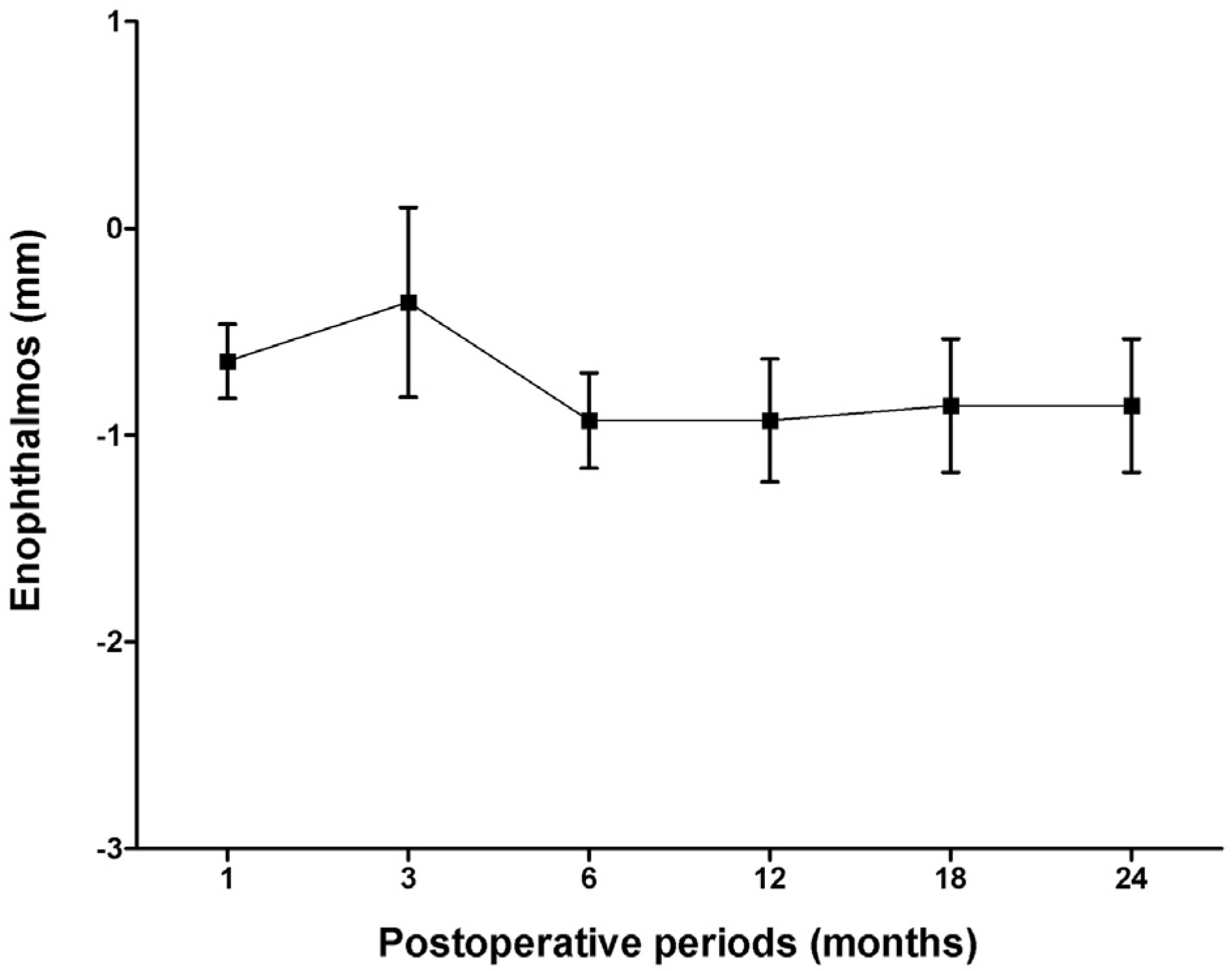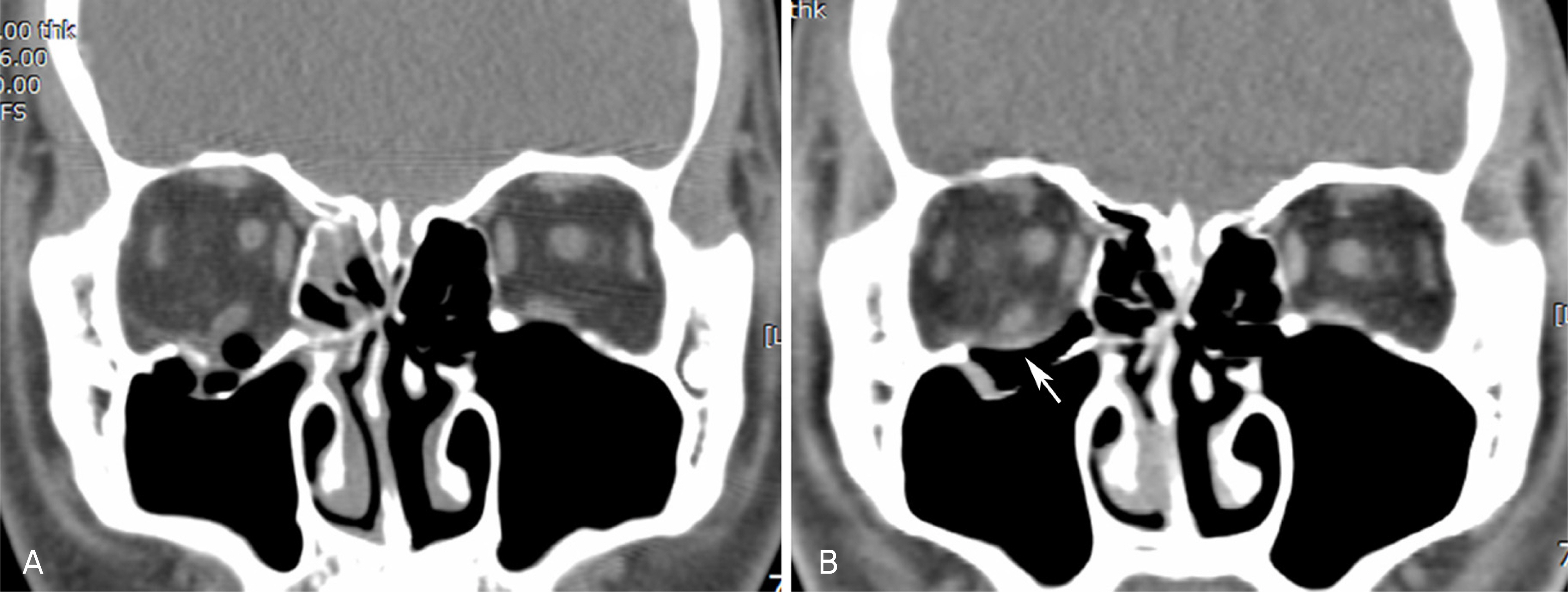J Korean Ophthalmol Soc.
2009 Dec;50(12):1761-1767. 10.3341/jkos.2009.50.12.1761.
Results of Reconstruction of Orbital Wall Fracture With Bioresorbable Plate
- Affiliations
-
- 1Department of Ophthalmology, Ajou University School of Medicine, Suwon, Korea. drkook@ajou.ac.kr
- KMID: 2212985
- DOI: http://doi.org/10.3341/jkos.2009.50.12.1761
Abstract
- PURPOSE
To investigate the long-term results and complications of orbital wall fracture reconstruction using the bioabsorbable orbital implant, Macropore(R) orbital floor liner.
METHODS
This retrospective study included patients who underwent the reconstruction of an orbital wall fracture using Macropore(R) orbital floor liner and completed a postoperative follow-up longer than 6 months. The enophthalmic values as well as the data of ocular movement and diplopia was collected from the medical records of each patient and analyzed.
RESULTS
A total of 35 patients were evaluated with an average follow-up period of 14.0 months. The average enophthalmic value of 29 patients, whose reconstruction was primarily indicated from enophthalmic tissue, was 0.90 mm at the last follow-up. No significant progression of enophthalmos was observed at postoperative 12, 18 and 24 months when compared with the enophthalmic value at postoperative 6 months. All 15 patients who have had the limitation of ocular movement or diplopia preoperatively resolved completely or improved to the degree that no clinically significant limitation or diplopia further existed. No complications such as dislocation of implant, infection, and aggravation of ocular limitation were observed during the follow-up period.
CONCLUSIONS
Macropore(R) orbital floor liner may be regarded as a useful implant in reconstruction of orbital wall fracture with no significant implant-related complications during its absorption.
MeSH Terms
Figure
Cited by 2 articles
-
Repair of Inferomedial Orbital Wall Fractures with Bony Strut Loss by Overlapping Absorbable Copolymer
Ah Young Choi, Su Youn Park, Koung Hoon Kook
J Korean Ophthalmol Soc. 2013;54(9):1315-1320. doi: 10.3341/jkos.2013.54.9.1315.Reconstruction of Orbital Medial Wall Fracture with Absorbable and Non-Absorbable Orbital Implant: Comparative Study
Min Kyung Kim, Sun Young Jang, Hye Sun Choi
J Korean Ophthalmol Soc. 2014;55(5):640-645. doi: 10.3341/jkos.2014.55.5.640.
Reference
-
References
1. Holmes RE, Cohen SR, Cornwall GB, et al. MacroPore resorbable devices in craniofacial surgery. Clin Plast Surg. 2004; 31:393–406.
Article2. Park YJ, Chung IY, Seo SW. An analysis of orbital reconstruction with bioresorbable plate though orbital volume assessment. J Korean Ophthalmol Soc. 2008; 49:1046–53.3. Chi MJ, Jeung JW, Lee JH. Reconstruction of orbital wall fracture with resorbable copolymer mesh. J Korean Ophthalmol Soc. 2006; 47:1021–30.4. Kontio RK, Laine P, Salo A, et al. Reconstruction of internal orbital wall fracture with iliac crest free bone graft: clinical, computed tomography, and magnetic resonance imaging follow-up study. Plast Reconstr Surg. 2006; 118:1365–74.
Article5. Krishnan V, Johnson JV. Orbital floor reconstruction with autogenous mandibular symphyseal bone grafts. J Oral Maxillofac Surg. 1997; 55:327–30.
Article6. Kraus M, Gatot A, Fliss DM. Repair of traumatic inferior orbital wall defects with nasoseptal cartilage. J Oral Maxillofac Surg. 2001; 59:1397–400.
Article7. Guerra MF, Perez JS, Rodriguez-Campo FJ, Gias LN. Reconstruction of orbital fractures with dehydrated human dura mater. J Oral Maxillofac Surg. 2000; 58:1361–6.8. Kim HK, Lim HS, Chung WS. Surgical Effect of Medpor in the Reconstruction of Orbital Wall Fracture. J Korean Ophthalmol Soc. 1998; 39:623–30.9. Villarreal PM, Monje F, Morillo AJ, et al. Porous polyethylene implants in orbital floor reconstruction. Plast Reconstr Surg. 2002; 109:877–85.
Article10. Mauriello JA Jr., Wasserman B, Kraut R. Use of Vicryl (polyglactin-910) mesh implant for repair of orbital floor fracture causing diplopia: a study of 28 patients over 5 years. Ophthal Plast Reconstr Surg. 1993; 9:191–5.11. Burres SA, Cohn AM, Mathog RH. Repair of orbital blowout fractures with Marlex mesh and Gelfilm. Laryngoscope. 1981; 91:1881–6.
Article12. Iizuka T, Mikkonen P, Paukku P, Lindqvist C. Reconstruction of orbital floor with polydioxanone plate. Int J Oral Maxillofac Surg. 1991; 20:83–7.13. Tuncer S, Yavuzer R, Kandal S, et al. Reconstruction of traumatic orbital floor fractures with resorbable mesh plate. J Craniofac Surg. 2007; 18:598–605.
Article14. Hwang JH, Kwak MS. Residual Diplopia and Enophthalmos after Reconstruction of Orbital Wall Fractures. J Korean Ophthalmol Soc. 2003; 44:1959–65.15. Hu J, Liu X, Ma PX. Induction of osteoblast differentiation phenotype on poly (L-lactic acid) nanofibrous matrix. Biomaterials. 2008; 29:3815–21.16. Rozema FR, Bos RR, Pennings AJ, Jansen HW. Poly (L-lactide) implants in repair of defects of the orbital floor: an animal study. J Oral Maxillofac Surg. 1990; 48:1305–9.
- Full Text Links
- Actions
-
Cited
- CITED
-
- Close
- Share
- Similar articles
-
- An Analysis of Orbital Reconstruction with Bioresorbable Plate Through Orbital Volume Assessment
- The Inferior Orbital Wall Reconstruction by Titanium Micro-mesh Remodeling
- Surgical Effect of Medpor in the Reconstruction of Orbital Wall Fracture
- Management Of Medial Orbital Wall Fracture
- Reconstruction of Orbital Wall Fracture with Resorbable Copolymer Mesh





